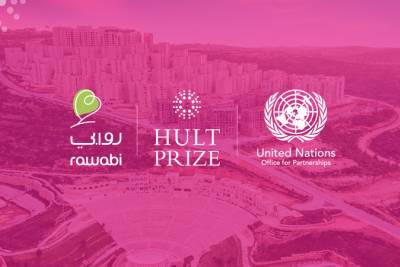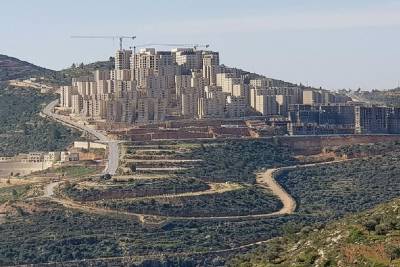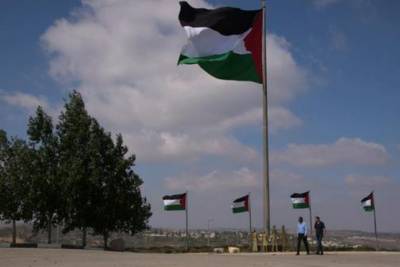Rawabi, architectural prophecy of an unequal Palestinian state
The Funambulist - Léopold Lambert - This article is the fourth in a series of five that functions as a report on my most recent stay in Palestine in July. While the first three parts were in Jerusalem-Al Quds, this fourth part is devoted to a city that did not exist a few years ago. Located in the West Bank between Nablus and Ramallah (see map at the end of the text), the new city of Rawabi concretizes a number of crucial questions about the present and the future of Palestine. Elaborated by the Bayti Real Investment Company, owned in partnership by the Diar Real Estate Investment Company of Qatar and the Palestinian company Massar International owned by the charismatic Bashar Masri, the construction of Rawabi began in 2010 at the peak of the committed development policy by then Prime Minister Salam Fayyad, former economist at the World Bank and the International Monetary Fund (IMF).
This type of development has particularly changed the aspect of Ramallah, the de factocapital of the Palestinian Authority, in a deliberate indifference to the Israeli occupation and a consecration of the 1993 Oslo Accords. These new neighborhoods were constructed in the north of Ramallah (see the article "Building the Ramallah Bubble") or Rawabi, and it became commonplace to compare their architectural aesthetics and urban typology at the top of the hills ("rawabi" itself). even means "hills") to nearby Israeli settlements - what I have called in the past a "Stockholm Architectural Syndrome".
As Tina Grandinetti described in an article written for the second edition of Funambulist Magazine, Suburban Geographies (Nov-Dec 2015) , the way in which architecture reinforces the social segregation that a city like Rawabi produces is obvious, and the many luxury brands (Ferrari, Armani, Lacoste, Tommy Hilfinger, Mango, etc.) that ostensibly display "next-door" signs on the front of their future stores in Rawabi, certainly contribute to this. Nevertheless, the questions that Rawabi triggers are too important to be dismissed under superficial criticism.

Complicit indifference versus political indifference
The first concerns the relationship to Israeli Apartheid, which necessarily conditions the existence of any project in Palestine. In the mouth of Fayyad or Masri (see for example the 2012 Dutch documentary "Rawabi: The Promised Palestinian City"), the term "occupation" comes back as a mantra, seemingly inevitable force without apparent entity apparent: the occupation as a climatic condition . That does not mean, however, that any Palestinian project (be it architectural or anything else) should be, explicitly and entirely, dedicated to the formation of resistance to Israeli Apartheid (through which I was and continues to be responsible, to some extent), since this kind of expectation would be a form of essentialization of Palestinianness, which would only exist through its resistive training mobilized against Israel, which would ultimately strengthen Zionist ideology that recognizes the Palestinian presence only as a contemporary antagonistic creation of the creation of the State of Israel. This (often external) expectation was humorously illustrated by Sabrien Amrov when she wrote, three days earlier, in a Facebook post: "Whenever I tell academics that I want to write about how the Palestinians like, it does not interest anyone. But if I say how the Palestinians love as a form of resistance, then wow, that's hot. The effective forms of indifference to Israeli Apartheid are those that (deliberately or not) exist and take shape without him, not in spite of himself. To this end, we could (perhaps provocatively) claim that one of the most literal forms of Palestinian indifference could be found in the strategies developed by the Boycott Divestment Sanctions (BDS) platform, since it aims to fundamentally separate from any economic or cultural link with Israeli government companies and programs. In this respect, Rawabi represents the exactly opposite form of Palestinian indifference by adopting the logic that "business is not politics" and therefore working with a significant amount of Palestinian companies and materials "provided to [offer] them a good price, "says Masri.

State Policy
The second of the issues raised by Rawabi can be found in his explicit policy as a symbol and prelude to the establishment of a Palestinian state. In this regard, Rawabi's first and main problem is the preemptive right policy that the Palestinian Authority resorted to when it seized 6 square kilometers of land from neighboring villages, Atara and Ajul, to allow the construction of the new city. On a land perpetually marked (and daily crossed) by the history of the territorial dispossession that the Nakba and the Israeli occupation have created, and only a few hundred meters from the Israeli settlement of Ateret, this other form of Authoritarian dispossession embodies a heavy violence, (obviously) locked in the official narrative on Rawabi - the destruction of the ecosystem of a whole hill to build a self-proclaimed "green city" could be another.Since 1994 and the creation of the Palestinian Authority following the Oslo Accords, Palestinians in the West Bank have experienced new forms of state violence (police violence, arbitrary arrests, dispossession of the land, etc.), which during the last 27 years were exclusively caused only by the Israeli occupation army - and, to a lesser extent, by the Jordanian and British states during the previous 47 years.
The last 23 years (and in particular, the years following the second Intifada) have therefore provided a preview of what the Palestinian state might look like if it were created within the framework envisioned by the Palestinian Authority. , the so-called "International Community" and, despite claims to the contrary, the Israeli government itself (which hopes to acquire, through the establishment of a Palestinian state, the legitimacy of its ethnocracy).
This state project is characterized by a spatial framework that makes the West Bank (and East Jerusalem) its main and, perhaps, exclusive territory. The subject of the Gaza Strip, with its 1,800,000 inhabitants, the vast majority of whom live in extremely disastrous conditions (of which the Palestinian Authority is partly responsible), and the complexity due to the territorial separation between the two regions are not never seriously debated. Then, one can suddenly discover plans to establish a Palestinian mini-state in the Sinai Peninsula for Palestinians in Gaza (Al Jazeera, July 2017).
The Palestinian state project does not express any prospect for the 5 million Palestinian refugees living in camps in Lebanon, Syria, Jordan, Gaza and the West Bank.Meanwhile, the Israeli government is considering ways to deprive Israeli Palestinians of their citizenship through a population transfer project (The Electronic Intifada, July 2017) - it is interesting to note that a number of future residents of Rawabi are part of this population - which could be linked to the threats made by the Minister of State Tzachi Hanegbi who recently threatened the Palestinian Israelis with a third Nakba (+972, July 2017).
Rawabi represents an architectural prophecy of a state of this kind: that of a sacrificial urbanity that symbolizes and reinforces the acceptance of the price to be paid by a large number so that a small number can access the freedom of a capitalized complicit existence. and become what Eva Schreiner calls "consumer citizens" in an article about the new city (unpublished, 2013). But here again, we should not evacuate the nuances of reality too quickly by a peremptory judgment (especially if it comes from an external position like the one I occupy). It is difficult not to be sensitive to the emotionally charged words of future residents (or, sometimes, Masri himself) interviewed in the Dutch documentary mentioned above, and we can hear, through these testimonies, the joy in front of a rare opportunity to act in impossible conditions until then. Moreover, more than an accomplice of Israeli Apartheid, one can perceive Rawabi and its many problematic dimensions as its result. Colonialism in general and Apartheid in particular do not work with the strict binary qualification of sets ("colonizers" versus "colonized", "white" versus "black") by which we usually define them - an absolutist schema would inevitably lead to to its rejection by a population that would have basically nothing to lose.
Colonial societies, on the other hand, operate with a classification gradient that corresponds to a proportional degree of administrative violence to which they are subjected. Israeli Apartheid is violently reinforcing this colonial hierarchy and the reality is experienced differently by members of the diaspora, Palestinian Israelis, East Jerusalem residents, West Bank residents with a work permit to the west of the Gaza Strip. Apartheid, residents of the West Bank who do not have this permit, refugees in the West Bank, residents of Gaza, refugees in Gaza, refugees abroad, etc. - this classification is not exhaustive (far from it) and ends up understanding as many ramifications as Palestinians. We can not therefore attribute the social divergences created by this system (like those created by the capitalist system) to individual responsibilities, but rather to the very structures of the system itself. As such, Rawabi would rather be the ostentatious crystallization of this kind of divergence than their cause.
GENERAL MAPS AND CLOSE-UP

Card specially designed for this article. The blue areas are Israeli settlements in the West Bank and East Jerusalem.


Rawabi from the village of Ajul.


Associated marks are posted in different places in the city.

The Qatar flag next to the Palestinian flag.


The Rawabi mosque under construction.

To view original article in French, Click Here.
To view translated article, Click Here.



